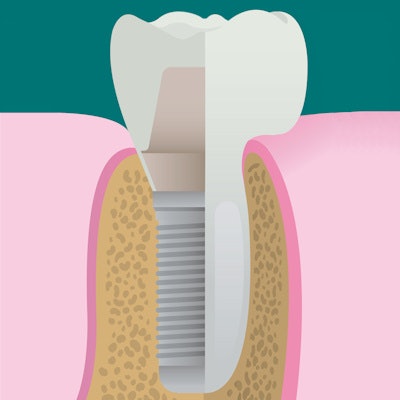
Differences between implant surfaces at the nanoscale level appear to at least partially determine which have a higher chance of success after an implant procedure, according to a new study. The research may lead to implants that better adhere to bone and soft tissue.
Previous research has shown that the SLActive surface on titanium (Ti) and titanium-zirconium (TiZr) alloy implants made by Straumann performs better than the company's implants with a SLA surface. Researchers from the University of Manchester in the U.K. and the Straumann research department in Switzerland now believe that the difference between the surfaces may be attributed to protrusions only observable at the nanoscale level.
"Acquired data suggest that both nanoscale protrusions and a thinner layer of adventitious carbon contribute to the more rapid osseointegration of SLActive dental implants," wrote lead study author Matthew Murphy and colleagues (Dental Materials, November 9, 2016).
A difference of 1 nm
Straumann's Ti and TiZr implants undergo a similar regimen for getting a SLA surface and SLActive surface. However, implants with the SLActive surface bond with bone and tissue faster than ones with a SLA surface, and they also perform better in extraction testing in the first one to two months after insertion. Researchers aren't sure why this distinction exists.
The only macroscopic difference between the two surfaces is that the SLActive surface is superhydrophilic, meaning water molecules that come in contact with the surface spread out completely. Meanwhile, the SLA surface is hydrophobic, meaning water molecules that come in contact with the surface tend to maintain their shape. The researchers, therefore, wanted to see if there were any observable differences between SLActive and SLA surfaces at the nanoscopic level.
Using various spectroscopy, x-ray, and microscopy tests, the researchers evaluated differences between four variations of Ti and TiZr implants by Straumann:
- Titanium with a SLA surface
- Titanium-zirconium alloy with SLA surface
- Titanium with a SLActive surface
- Titanium-zirconium alloy with a SLActive surface
While all the materials appeared similar at 25 µm, the SLActive surfaces had significantly more protrusions and ridges than the SLA surfaces at 250 nm. The researchers hypothesized that this could be caused by a difference in how solutions form on the surfaces during their creation.
 Illustrations of the variations between the four implant surfaces when at the nanoscale level. Image from "Toward optimizing dental implant performance: Surface characterization of Ti and TiZr implant materials," Dental Materials, November 9, 2016.
Illustrations of the variations between the four implant surfaces when at the nanoscale level. Image from "Toward optimizing dental implant performance: Surface characterization of Ti and TiZr implant materials," Dental Materials, November 9, 2016.The researchers also used a formula to estimate the exterior thickness of the carbon layer surrounding each surface. The SLActive surfaces had a carbon layer thinner by approximately 1 nm than the SLA surfaces. They noted that this miniscule difference could affect the hydrophobic and hydrophilic properties of the surfaces and also contribute to the increased speed in which SLActive implants adhere to bone and soft tissue after procedures.
"Presuming that a reduction in adventitious carbon is a key factor in improved osseointegration kinetics (as well as hydrophilicity) of SLActive substrates, it is perhaps surprising that a mere thinning of the carbon layer by ~ 1 nm influences these macroscopic properties to such an extent," the authors wrote. "Further studies are required, including employment of other spectroscopic probes."
Engineering better implants
“It is perhaps surprising that a mere thinning of the carbon layer by ~ 1 nm influences these macroscopic properties.”
One drawback of this study was that it focused solely on Straumann implants, so that differences between the surfaces of implants made by other companies were not explored. Furthermore, although the study found observable differences between the SLA and SLActive surfaces, the researchers don't exactly know why these differences exist or how they form.
While they do have several hypotheses, the researchers call for future studies to continue to explore why the SLActive surface works better. Future studies exploring the role of protrusions and a thinner carbon layer may help further improve implants and implant surfaces, the authors noted.
"Alikely surface characteristic contributing to rapid osseointegration (as well as superhydrophilicity) is the existence of nanoscale protrusions, which only appear on SLActive substrates," they concluded. "Concerning the adventitious carbon, which terminates all substrates, layer thickness also appears to be important, even though there is a decrease of only ~1 nm in depth on going from SLA to SLActive substrates."



















